| Manufacturers 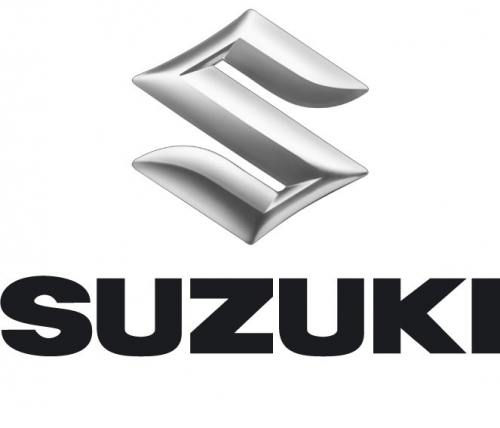 All have become accustomed to a smooth silk cooing Japanese 4-stroke engines. It is in the production of silk and began the history of one of the most popular manufacturers of motorcycles, ATVs, scooters and other equipment - Suzuki. All have become accustomed to a smooth silk cooing Japanese 4-stroke engines. It is in the production of silk and began the history of one of the most popular manufacturers of motorcycles, ATVs, scooters and other equipment - Suzuki.
Michio Suzuki founded the company, who was born in Hamamatsu in 1887. In the same city, and is now headquartered Suzuki.
Silk production was an important production in Japan. So, as there was a demand, in 1909, Michio Suzuki organized enterprise manufacturing looms for silk. However, the production of one machine was boring for Suzuki, and in 1937 he made a prototype of the engine, and in the future even got a license to manufacture cars (called Austin 7). But in those years, was relocated to the MIC and the company instead of Suzuki cars switched to guns and military equipment. After the war, production again shifted to silk machines, but the demand for them has fallen dramatically. The company began to look for myself, producing agricultural machines and heaters.
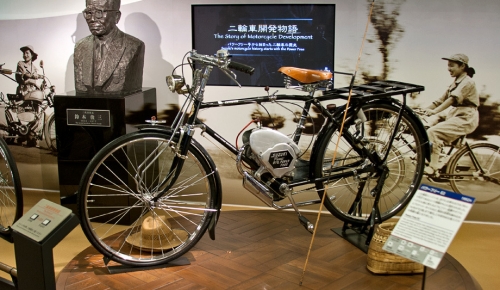 Mito Suzuki, despite his 70 years of age, saw the demand in the postwar years, affordable and accessible vehicles - motorized bicycles. The prototype was designed only for November 1951. Moto-bike equipped with 2-stroke engine with a capacity of 36 cubic meters. centimeters. This engine can be mounted on any bicycle frame above the bottom bracket. Already in June 1952, was sold to the first model motorcycle bike Suzuki Power Free. In March of the following year released a new model - Suzuki Diamond Free with a more powerful 60 cc engine. Diamond Free for the first year of its design won the Mount Fuji mountain competitions. Mito Suzuki, despite his 70 years of age, saw the demand in the postwar years, affordable and accessible vehicles - motorized bicycles. The prototype was designed only for November 1951. Moto-bike equipped with 2-stroke engine with a capacity of 36 cubic meters. centimeters. This engine can be mounted on any bicycle frame above the bottom bracket. Already in June 1952, was sold to the first model motorcycle bike Suzuki Power Free. In March of the following year released a new model - Suzuki Diamond Free with a more powerful 60 cc engine. Diamond Free for the first year of its design won the Mount Fuji mountain competitions.
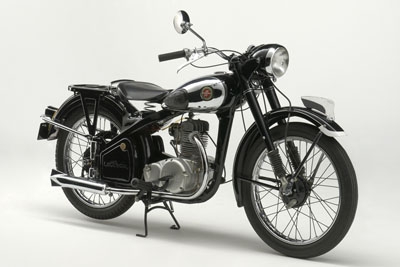 In May 1954, there is a first road bike company - Suzuki Colleda. Motorcycle with a 1-cylinder 4-stroke engine 90 cm3 in the first year won the competition on Mount Fuji in 85 contenders. In May 1954, there is a first road bike company - Suzuki Colleda. Motorcycle with a 1-cylinder 4-stroke engine 90 cm3 in the first year won the competition on Mount Fuji in 85 contenders.
Next model Suzuki motorcycle was released in 1955 - Suzuki Colleda ST with, 125 cc engine. She identified the direction of the motorcycle company.
In 1957, the construction of a new factory Suzuki, through which it was possible to increase the production capacity of the plants to near Honda. In that same year, the son of company founder Shunji Suzuki visited the United States and brought about the possibility of entering the North American market.
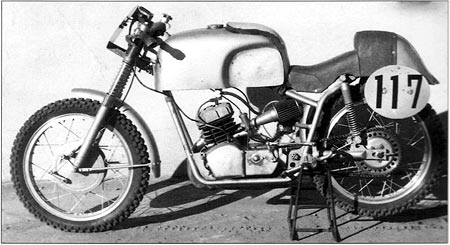 In 1959, Suzuki has developed a special racing 125 cc motorcycle - Suzuki Colleda RB, which has a 4-speed gearbox, telescopic forks and swinging arm rear suspension. In the Japanese competition, the new finished only fifth, behind motorcycles Honda. At the suggestion of founder Soichiro Honda, the motorcycle took part in the popular track racing in England on the Isle of Man in 1960. In 1959, Suzuki has developed a special racing 125 cc motorcycle - Suzuki Colleda RB, which has a 4-speed gearbox, telescopic forks and swinging arm rear suspension. In the Japanese competition, the new finished only fifth, behind motorcycles Honda. At the suggestion of founder Soichiro Honda, the motorcycle took part in the popular track racing in England on the Isle of Man in 1960.
part in the race did not bring direct profits, so the main motorcycle production consisted of the production of small road bikes. Number of motorcycles produced (for example, 2-stroke 1-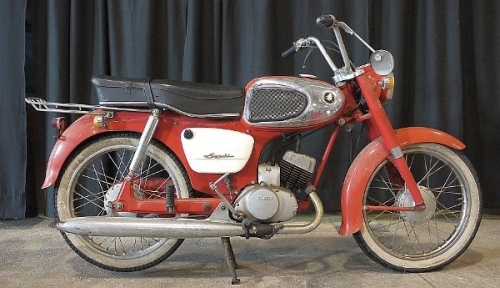 cylinder motorcycle series K and M) was huge. So in the 1960s. only models Suzuki K10 and K11 were produced over 500 thousand pieces. The models attracted buyers, among others, the oil injection system, allowing the rider having to manually mix the fuel mixture of gasoline and oil, as opposed to the other 2-stroke motorcycles (eg Vespa or Lambretta). Mixing oil for Suzuki established a special oily tank, from which the oil is reported in the controlled injection of the crankshaft, which, depending on engine speed and throttle opening supplied the engine oil. cylinder motorcycle series K and M) was huge. So in the 1960s. only models Suzuki K10 and K11 were produced over 500 thousand pieces. The models attracted buyers, among others, the oil injection system, allowing the rider having to manually mix the fuel mixture of gasoline and oil, as opposed to the other 2-stroke motorcycles (eg Vespa or Lambretta). Mixing oil for Suzuki established a special oily tank, from which the oil is reported in the controlled injection of the crankshaft, which, depending on engine speed and throttle opening supplied the engine oil.
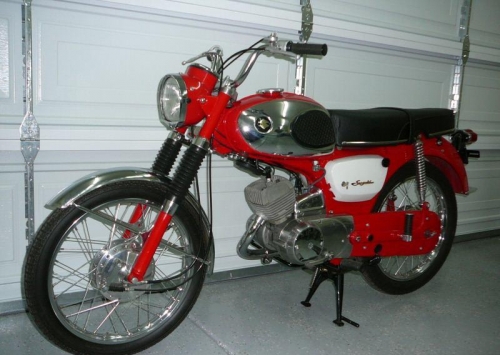 In 1964 he released a new model - Suzuki B100P (Bloop), which replaced the series K and M. Her popularity was so great that production continued until the mid-1970s (the last modification - Suzuki B120 Student). In 1964 he released a new model - Suzuki B100P (Bloop), which replaced the series K and M. Her popularity was so great that production continued until the mid-1970s (the last modification - Suzuki B120 Student).
In 1967, it developed a smaller motorcycle Suzuki A100, which produces up to 80 years. In this same period, have been released and motorcycles Twinace T10 with 246 cc engine. Motorcycles have been made on the basis of 2-cylinder Suzuki Colleda TT 1956. The frame is made of pressed steel Imeda pretty soft lines. T10 in 1963, has been equipped with electric starter and flashing corners.
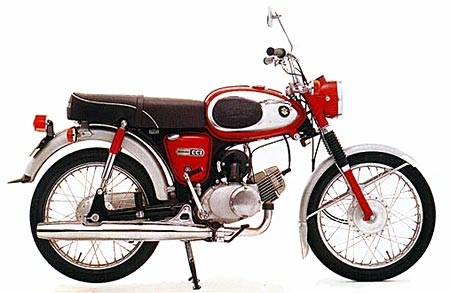
In these years of racing success nebyli outstanding. On track racing's 1960-1961 Suzuki managed to take only 15th place. The company was the best racer Mitsuo Ito, who later became the manager of racing.
But the company managed to win over to his equipment from the East German racing team MZ, who spoke about the technology of two-stroke engine with a ball valve. Technology could improve the performance of new engines and Suzuki in 1962 have real success in sport. Thus was won the world championship in the class of 50 cubic meters. see (Denger pilot), and in 1963 and 1965 Aussie Hugh Anderson became the world champion in the 125 cc motorcycle. See the end of the 1960s, any competition motorcycles from 50 cc engine, Suzuki took the lead. Forces riders Anderson and Hans-Georg, piggy-winning Suzuki was supplemented with 4 more league titles.
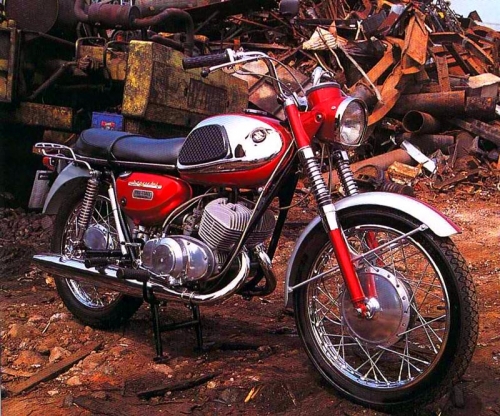 Before 1966, even motorcycles participating in the race is the normal road bikes - up to release of the first sports bike Suzuki T20 Super Six (U.S. Suzuki X6). Sport-bike set a new 2-stroke 2-cylinder 280 cc engine. centimeters with 29 horsepower. The cylinders were cast from an alloy 24mm carburetor, transmission was a 6-speed. To reduce weight, Suzuki abandoned the electric starter. Sport-bike a top speed of 145 km/h, which was very good for its class. The model has become very popular and profitable for the company. Before 1966, even motorcycles participating in the race is the normal road bikes - up to release of the first sports bike Suzuki T20 Super Six (U.S. Suzuki X6). Sport-bike set a new 2-stroke 2-cylinder 280 cc engine. centimeters with 29 horsepower. The cylinders were cast from an alloy 24mm carburetor, transmission was a 6-speed. To reduce weight, Suzuki abandoned the electric starter. Sport-bike a top speed of 145 km/h, which was very good for its class. The model has become very popular and profitable for the company.
this success next year Suzuki produces other sport-bike - Suzuki T200, has developed a speed of 177 km/h
Still later there Suzuki T500 Cobra (U.S. Suzuki Titan). These models are also very popular. T500 was made before 1977 under the name of Suzuki GT500 and have disc brakes and electronic ignition.
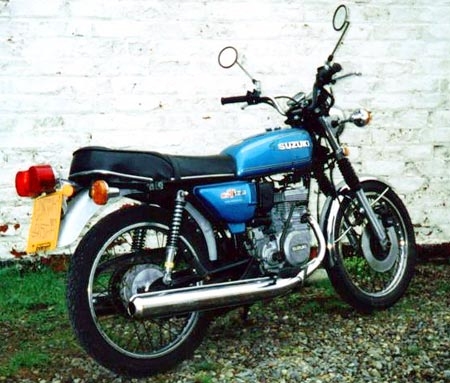 In 1972, new 2-stroke 3-cylinder models of motorcycles - Suzuki GT380 and Suzuki GT1550 (with six-speed transmission), as well as two-cylinder Suzuki GT125 and Suzuki GT185, were equipped with fairings Ram Air. In 1972, new 2-stroke 3-cylinder models of motorcycles - Suzuki GT380 and Suzuki GT1550 (with six-speed transmission), as well as two-cylinder Suzuki GT125 and Suzuki GT185, were equipped with fairings Ram Air.
In 1971, Suzuki released the first off-road motorcycle (actually dual-purpose bike that can move both on road and off-road) - Suzuki TS125. This bike is the first in its series of TS, vkotoruyu further includes models TS100 (having a suction ball valve), TS185, TS50 and TS400. TS400 made not long, but the other model series developed and produced in the 1980s and 1990s. 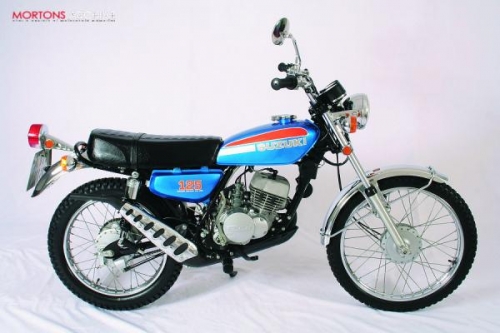
In 1978 he became a role model Suzuki 2-stroke GP100/125, which replaced the old Suzuki B120.
Specializing in 2-stroke engines (which is equipped with massive mopeds 50 and 70 cu. cm open frame) does not interfere with Jehan to create a more efficient engines for large motorcycles, the over-production of the experience engine was (eg released in 1971, the 3-cylinder engine 6T750, called Kettle in Britain and Water Buffalo in the U.S., as it used a new water cooling system).
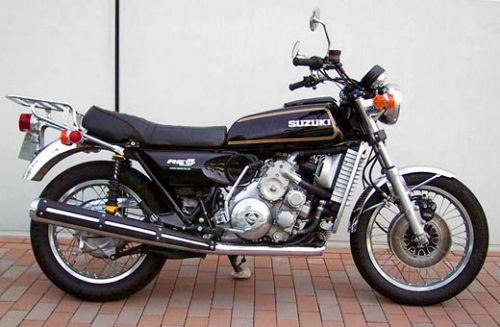 In 1974 he had a bad experience with the rotary engine in the model Suzuki RE5. Engine because of cooling water was heavy and less economical than the GT750, the engine gave out less power. In 1974 he had a bad experience with the rotary engine in the model Suzuki RE5. Engine because of cooling water was heavy and less economical than the GT750, the engine gave out less power.
Rejecting these types of engines, it was decided to make more fuel-efficient 4-stroke. And during the second half of the 70's, the company has equipped all its models are average motorcycle 4-stroke engines.
In 1976, Suzuki was even able to slightly exceed its direct competitors, releasing Suzuki GS750 with a 4-stroke engine with 68 horsepower, air-cooled, two camshafts. Model turned faster than counterparts Honda and Kawasaki, while it had a more rigid frame and it was a little easier to manage.
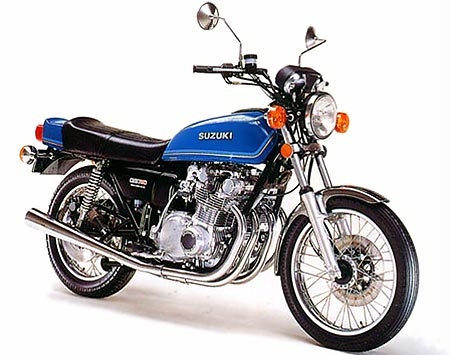 GS750 success has enabled the company to produce and a larger model - 1977 Suzuki GS1000 was issued with an engine 997 cu. see the power was 87 hp and a top speed was 217 km/h In addition, the bike has adjustable suspension and has been well managed. GS750 success has enabled the company to produce and a larger model - 1977 Suzuki GS1000 was issued with an engine 997 cu. see the power was 87 hp and a top speed was 217 km/h In addition, the bike has adjustable suspension and has been well managed.
In 1981, the issue of sports GS series was discontinued and replaced by a new series of GSX. Its main distinguish was the use of 4-stroke engines. Instead of a motorcycle with a driveshaft class tourist GS850 in 1980, was released GS1000G, replaced in 1983 by Suzuki GS1100G.
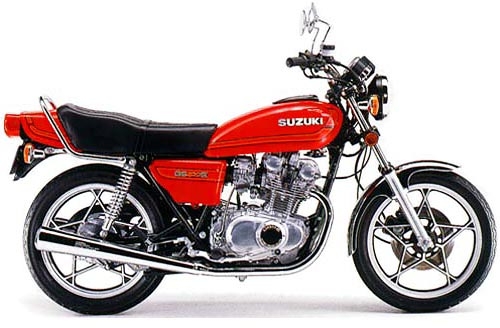 Another one of the best selling models of Suzuki is a 2-valve two-stroke Suzuki GS400 with air cooling, and the shaft gear driven control system. At its base models were developed Suzuki GS425 (1979), Suzuki GS450 (1980) and Suzuki GS500 (1989). These models have not used any new technical solutions, but were cheap and reliable with good performance. Another one of the best selling models of Suzuki is a 2-valve two-stroke Suzuki GS400 with air cooling, and the shaft gear driven control system. At its base models were developed Suzuki GS425 (1979), Suzuki GS450 (1980) and Suzuki GS500 (1989). These models have not used any new technical solutions, but were cheap and reliable with good performance.
In 1984, the largest off-road motorcycle was a Suzuki DR600, which had a 4-valve cylinder head and engine capacity of 44 horsepower. In 1987 he published another model - Suzuki DR750, on the basis of which appeared DR800 with engine 750 cc. centimeters. This model was notable for being the largest single-cylinder motorcycle. However, for off-road motorcycle was a big strong is not the best option.
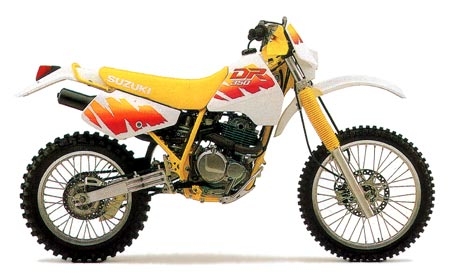 In 1991 there Suzuki DR350, which was more suitable size and weight (it was easier to pick up in the fall, it is easier to control when driving off-road). In addition there was an even more lightweight model - Suzuki DR125. Basic road bikes in those years were 4-stroke single cylinder motorcycles and camshaft located in the head - Suzuki GN250, GN400 and GS125. In 1991 there Suzuki DR350, which was more suitable size and weight (it was easier to pick up in the fall, it is easier to control when driving off-road). In addition there was an even more lightweight model - Suzuki DR125. Basic road bikes in those years were 4-stroke single cylinder motorcycles and camshaft located in the head - Suzuki GN250, GN400 and GS125.
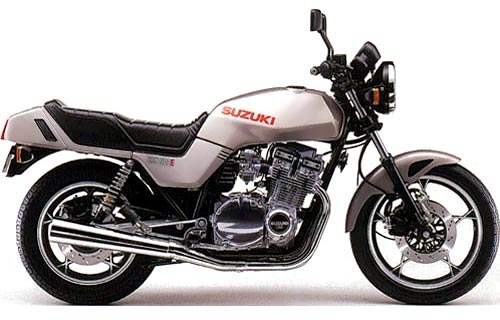 As stated earlier, the sports series GSX replaced GS. New sports line of Suzuki began with the start of production models and GSX1100 GSX750. They had the cylinder head with four-valve TSCC (Twin Swirl Combustion Chamber). The combustion chamber has a square cross-sections, for maximum twist that improves combustion. So as these bikes were equipped with telescopic forks, air-adjustable shock absorbers and large square headlights. As stated earlier, the sports series GSX replaced GS. New sports line of Suzuki began with the start of production models and GSX1100 GSX750. They had the cylinder head with four-valve TSCC (Twin Swirl Combustion Chamber). The combustion chamber has a square cross-sections, for maximum twist that improves combustion. So as these bikes were equipped with telescopic forks, air-adjustable shock absorbers and large square headlights.
Later appears Suzuki Katana, which had a low drive and a small fairing. The model is made with a 4-cylinder 16-valve engines from 250 to 1100 cu. see
Since 1983, and in a 4-liter engines were used on the 4-D-valve, increasing the power to 65 hp. These engines are installed on new alloy frame with square cross sections. In addition, the motorcycle was used semi fairing, rear suspension with mono shock and front forks neprovalivayuschiesya.
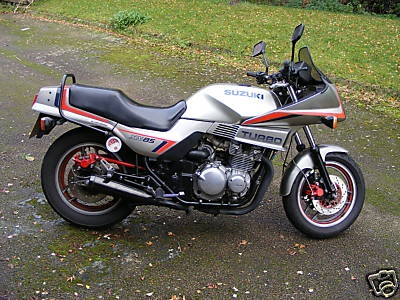 cylinder heads with four-valve installed on engines with 2 cylinders. Also, to keep up with other manufacturers, has released model Suzuki XN85 Turbo turbo-supercharged 4-cylinder water-cooled engines. But the resulting power of 85 horsepower does not justify such a complication design. cylinder heads with four-valve installed on engines with 2 cylinders. Also, to keep up with other manufacturers, has released model Suzuki XN85 Turbo turbo-supercharged 4-cylinder water-cooled engines. But the resulting power of 85 horsepower does not justify such a complication design.
In mid-1980s, Suzuki has released a series of motorcycles GSX-R, similar to enduro bikes of the early 1980's (in which Suzuki has managed to win sports awards). Motorcycles have the frame of a new line of aluminum bars and lightweight 4-cylinder engine, which is partially cooled by air, partly oil with a special oil cooler and 2 oil pumps. The oil supply so was increased 2-fold and, because of the oil film which covers the lower part of the piston crowns. Such a type of cooling the main drawback was the selection of the peak power of the 7 and thousands of revolutions, while the maximum was - 10 thousand. Subsequently held a number of improvements that could improve the situation, but did not correct it completely, and therefore to the 1998 Suzuki engines in volume of 750 cubic meters. cm with a power of 135 horsepower is used in conjunction with water-cooled fuel-injected.
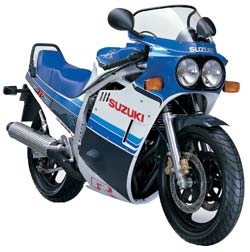 The model Suzuki GSX-R750 was able to establish new standards and popularized the serial replica racing motorcycles. Bike was used as a club racing, which can be supplemented with a racing rig, making it competitive in races or Superstok Superbike category. The model Suzuki GSX-R750 was able to establish new standards and popularized the serial replica racing motorcycles. Bike was used as a club racing, which can be supplemented with a racing rig, making it competitive in races or Superstok Superbike category.
Following the Suzuki GSX-R750, appeared less powerful models in this series with engines 250, 400 and 600 cu. see motorcycles with engines of 250 and 400 cu. cm acted only for the Japanese market, but the 600-minute version of the well bottoms proved itself in the European Supersport racing series in its category.
But released in 1989 Sport Touring model Suzuki GSX600F and GSX750F were on a more mundane level of popularity and in 1998 was seriously reworked.
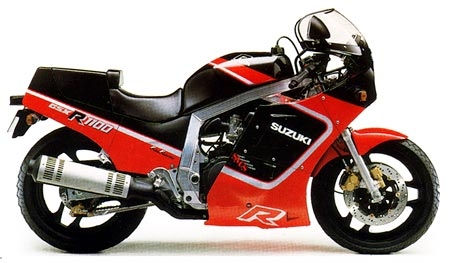 In 1987, there was a powerful motorcycle Suzuki GSX-R1100. Due to its more powerful engine and a wider range of power take-off, the bike is easy to use in everyday driving. GSX-R1100 a top speed of 249 km/h In 1987, there was a powerful motorcycle Suzuki GSX-R1100. Due to its more powerful engine and a wider range of power take-off, the bike is easy to use in everyday driving. GSX-R1100 a top speed of 249 km/h
image series based on the origin of motorcycle racing for many hours, which helped take the motorcycle line niche market.
Another series - a series of V-shaped two-cylinder two-stroke motorcycles started with model Suzuki RG250. Bike was built to race the Grand Prix. In 1990, Suzuki released the civilian version of the motorcycle as close to racing grandparent - RGV250. Bike had V-shaped two-cylinder engine with 60 horsepower, capable of accelerating to 217 km/h
 In 1995, the company releases a new attractive model for the market - Suzuki Bandit 600. The motorcycle is designed to drive both on public roads and off-road. Bandit 600 equipped with the revised version of the engine from the GSX-R600 with a capacity of 80 horsepower and oil cooling. The engine was mounted on a steel tubular frame. Despite the fact that the bike was a street fighter or a race replica and not like the retro bikes, riding position is vertical. As an option to the standard delivery of the motorcycle was half-fairing. The motorcycle became very popular and pulls ahead of sales Suzuki. In 1995, the company releases a new attractive model for the market - Suzuki Bandit 600. The motorcycle is designed to drive both on public roads and off-road. Bandit 600 equipped with the revised version of the engine from the GSX-R600 with a capacity of 80 horsepower and oil cooling. The engine was mounted on a steel tubular frame. Despite the fact that the bike was a street fighter or a race replica and not like the retro bikes, riding position is vertical. As an option to the standard delivery of the motorcycle was half-fairing. The motorcycle became very popular and pulls ahead of sales Suzuki.
After Bandit 600, was released more powerful model - Suzuki Bandit 1200, which optionally can be ordered well as the semi-fairing.
popular model allowed Suzuki in late 1999 to create a competitor to its the same model in the same class - easier and more tech motorcycle Suzuki SV650 c V-shaped two-cylinder engine and with the same-the - fairing .
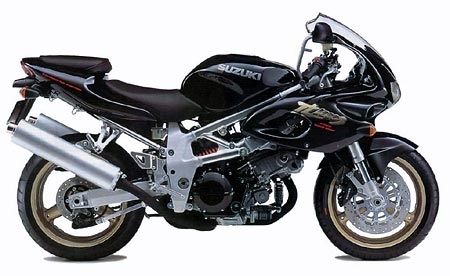 Japanese manufacturers not only among themselves but also with the motorcycle manufacturers in the U.S. and Europe. In 1997, Suzuki decided to outdo Ducati, releasing motorcycle TL1000 c V-shaped two-cylinder 8-valve engine and 2 camshafts. Power the bike was 125 horsepower, while it was cheaper analog of Ducati and even easier to use. In addition, the novelty was dynamic Japanese counterpart Honda VTR100 Firestorm. Did not stop there, Suzuki next year produces an even more powerful model - TL1000R, which became the base V-shaped bike Suzuki in the Superbike class. Japanese manufacturers not only among themselves but also with the motorcycle manufacturers in the U.S. and Europe. In 1997, Suzuki decided to outdo Ducati, releasing motorcycle TL1000 c V-shaped two-cylinder 8-valve engine and 2 camshafts. Power the bike was 125 horsepower, while it was cheaper analog of Ducati and even easier to use. In addition, the novelty was dynamic Japanese counterpart Honda VTR100 Firestorm. Did not stop there, Suzuki next year produces an even more powerful model - TL1000R, which became the base V-shaped bike Suzuki in the Superbike class.
In the late 90-ies of the 20th century began booming scooter (scooter), manufacturers have released to the market a lot of models of scooters in various sizes and capacities. Suzuki at the time managed to take a strong position in the production of scooters by releasing some of the best representatives of this class.
In 1998 he was released from the Suzuki Burgman scooter Engine 250 cc. But see, this power company seemed not enough and in 1999 he published a modification of a scooter with an engine capacity of 400 cc. see this model was the most powerful scooter the times of speeds up to 161 km/h!
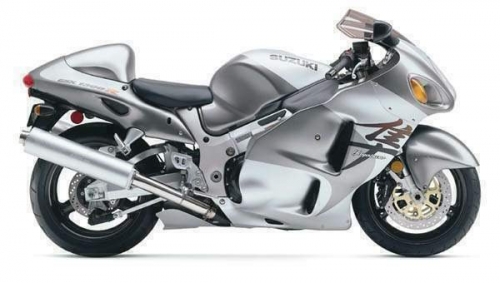 This also 1999 the super sport bike Suzuki GSX1300R Hayabusa (Japanese falcon), engine power is 173 horsepower. Bike in just 2.75 seconds top speed of 97km/h and 10 seconds can reach the speed is 225 km/h This also 1999 the super sport bike Suzuki GSX1300R Hayabusa (Japanese falcon), engine power is 173 horsepower. Bike in just 2.75 seconds top speed of 97km/h and 10 seconds can reach the speed is 225 km/h
the beginning of the 2000s, the technique Suzuki officially marketed in more than 190 countries.
In these years, Suzuki is on the 11th place in the world (and 5th in Japan) for the production of cars. In the year a 900 Suzuki 000 cars and 2 million motorcycles. The company employs around 15,000 staff.
2007 was marked in the calendar of the concept bike Suzuki Crosscage.
2009 - Suzuki opening of the museum in honor of the 100th anniversary of the company.
In 2012, together with the British company Intelligent Energy, Suzuki founded the company SMILE FC, which is to develop and produce a fuel cell system. The goal of the company - the organization of production ecological transport of the future generation. |